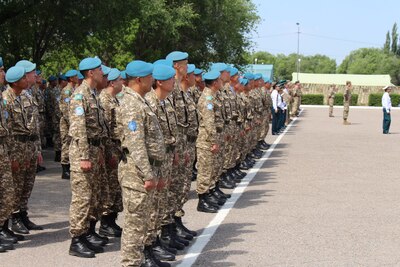
ILLISKY TRAINING AREA, Kazakhstan, June 20, 2019 —
As a Kazakhstani brass marching band played the national anthems of each nation in attendance, Soldiers representing six nations kicked off exercise Steppe Eagle 19 during an opening ceremony, June 17, to highlight the exercise’s role in promoting stability in the Central and South Asia region.
The U.S. Army Central-led exercise, which lasts 12-days, improves mutual understanding and interoperability among all participating nations, and helps promote regional stability in this vital area of the world. The annual, multilateral exercise also highlights the steady improvements by the Kazakhstani Ground Forces as a recognized member of the international security community.
At the ceremony’s opening, U.S. Army Lt. Col. Dan Horst, the Officer-in-Charge of the United States’ contingent to Steppe Eagle 19 and a Civil Affairs officer with U.S. Army Central, said the exercise recognizes Kazakhstan’s growing role in stabilizing Central Asia.
“We have seen the remarkable achievement of [Kazakhstan’s] involvement in various United Nations’ peacekeeping missions for several years, along with other coalition missions,” Horst said. “…We hope to contribute to their continued success with this exercise, in addition to sharing and learning important lessons and techniques from each other.”
Horst said the United States military remains committed to its Kazakhstani military partners and the rest of Central Asia to support the U.S. ambassador’s integrated country strategy as Kazakhstan continues to be an important member of the international community.
Along with the United States, the United Kingdom, Tajikistan, and Kyrgyzstan sent participants to Steppe Eagle 19, and Turkey and Uzbekistan also sent observers. The exercise refines peacekeeping operations and Peace Support Operations tactics, techniques and procedures at the platoon to brigade levels, and serves to train both U.S. and Kazakhstani Ground Forces.
Soldiers with the Arizona Army National Guard’s 1st Battalion, 158th Infantry Regiment, will train alongside members of the Kazakhstani Ground Force’s Peacekeeping Battalion in the Military Decision Making Process, checkpoints and convoy operations, counter-Improvised Explosive Device, public order, medical support, and civil-military operations, and culminates with a weeklong Field Training Exercise at the Peacekeeping Operations Training Center in nearby Chilikemer.
During the opening ceremony, the national flag of each participating nation was ceremoniously raised on a flagpole by a member its military, followed by a pass-and-review march in front of the parade field’s podium. From the podium, the six participating nations’ contingent leads proudly saluted as the nearly 400 multinational Soldiers marched by. Kazakhstani Gen. Maj. Abubakirov, commander of the Kazakhstani Air Assault Forces and the ceremony’s presiding officer, remarked that Steppe Eagle 19’s purpose is developing a common language and understanding among all participating nations.
“Our values and ideology are developed during the exercises,” Abubakirov said through a translator. “When we train together with our partners and allies, we not only exchange our military experience, but also our cultural knowledge, and thereby we better our understanding of one another.”
The Kazakhstani general also emphasized the Kazakhstani Ground Force’s increasing role in peacekeeping and stability operations throughout the world. For example, the Republic of Kazakhstan recently became a contributing member of the U.N. Interim Force in Lebanon (UNIFIL) for the first time by sending a 120-person peacekeeping contingent as part of the Indian battalion. Lebanon is also in the 20-nation U.S. Central Command area of responsibility that has had long-standing border security and humanitarian challenges spurred by conflict with and from neighboring countries Israel and Syria.
“In Lebanon, our service members are demonstrating their professional skills in peacekeeping, thanks to the experience we gained during the joint exercises of Steppe Eagle,” Abubakirov said.
For U.S. Army Capt. Ken Lorang, USARCENT’s Country Desk Officer for Kazakhstan in the command’s G5 Security Cooperation Division, Steppe Eagle 19 and other military-to-military engagements improve the overall effectiveness of coalition partners when working in unfamiliar environments, while also enhancing interoperability.
“Our respective forces are responsible for maintaining the upper hand to defend our nations and protect citizens,” Lorang said. “Military engagements – whether it is bilateral engagements, key leader engagements, or exercises – are ideal ways to prepare our forces to operate together with our strategic partners when needed.”
Under the National Guard’s State Partnership Program, U.S. states are paired with foreign nations to create security cooperation relationships and build partner capacity. Arizona is the state partner with Kazakhstan, and both have enjoyed a 25-year partnership as one of the original 13 State Partnership Programs that were established in 1993.
A closing ceremony for Steppe Eagle 19 is scheduled for June 27 at Illisky Training Area.



